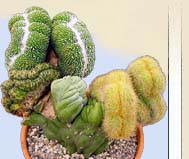Indoor
Floriculture

Leafy succulents
by Peter Lapshin

Cacti Library
'Cultivar' (V.Kalishev)

Moscow
Succulent Society

Moscow Indoor
Plant Club

Travels, nature,
botanical gardens

About Episcia
(Gesneriaceae)
 |
 |
CULTIVAR / КУЛЬТИВАР e-Magazine about exotic forms of Cactaceae ENGLISH / RUS-(Win1251) | |||
|
|
|

|
Mojave Desert Cacti by Vladimir Malov, California USA
Blue Diamond Ferocactus cylindreus Echinocereus engelmannii Escobaria vivipata v deserti Opuntia basilaris Opuntia engelmannii Cylindropuntia echinocarpa Cylindropuntia ramoissima When the rain eases up I throw my wet tent in the car – it'll dry out there – and go for a ride along the nearby Highway 159. In ten or so miles I stop by a limestone cliff dotted with Ferocacti that I could spot from the road. A full stream of rainwater runs at the base of the cliff. This place gets a lot more moisture, and unlike the desert slopes around it even has large willow trees and a lot of greenery. Cacti grow further up the slope, about thirty feet higher than the other plants, among the inhospitable sands and rocks. There are many young Ferocacti and Escobaria seedlings. Returning to the car I hit Highway 160 and in about twenty minutes reach a mountain pass. I want to check if there are any Echinocaraus mojavensis growing up here, half a mile above the desert floor. One of the slopes above the pass is densely covered with juniper and pine forest, the other side is mostly naked, with only low bushes and Opuntias showing. Which does suggest I might find other cacti as well. With the rain starting up again I head for the Opuntia-covered slope. These plants are new to me, and I'm not sure which species they are – possibly Opuntia engelmannii again. The plants grow low along the slope, never reaching higher than my knees. Among the Opuntias there are Echinocereus engelmannii plants. None of them are too large, and all of them have unusual almost white spines. Surprisingly there are also a lot of Escobaria desertii. I've never seen so many of these plants before, and always thought that it was a rare plant, but I guess the conditions are optimal here. Finally I get back in my car and drive to the airport. My four days of desert and cacti are over.
|
| Cultivar e-magazin: Copyright (c) by Valery Kalishev, Chelyabinsk, Russia, since 2000. Design and hosting by Peter Lapshin, since 2002. Contacts: Peter Lapshin |
|
|